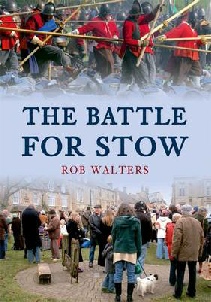
If you like it, please share it

This book is not simply a history of the battle or the town, rather an allegory describing
the battle for survival that many rural towns and villages are engaged in at present.
It uses the historic battle (the last in the Civil War) as a backcloth onto which
to describe the modern battles that exist nowadays - the fault lines that threaten
to tear towns like Stow asunder
The Battle for Stow
Three hundred and sixty three years before this book was written Sir Jacob Astley
led an army of 3,000 men out of Bridgnorth, a small town in the county of Shropshire,
towards Oxford -
The battle of Stow took place in 1646; the battle for Stow is taking place as
I write -
The Civil War has been written about extensively and from many viewpoints. Any attempts to provide a concise overview of the period preceding the war and of the war itself seem doomed to failure: it was, and remains, a complex stage in the evolving history of England. Imagine a country racked with problems: food prices were soaring as were taxes, the leader of the country was at odds with his own parliament, the Scots were revolting and so were the Irish, religious fundamentalists were vocal, foreign competition was undermining the key industries, and the government was perpetually short of money. Hey, this sounds rather familiar. Today Gordon Brown would frown in gloomy recognition of these problems and perhaps sympathise with the leader of those days, a fellow Scotsman trying to rule an unruly nation.
Unlike Gordon (I think) Charles the first truly believed that he had been chosen to rule by God, a belief that hardly encouraged compromise. In the words of a Venetian diplomat of the time, "This king is so constituted by nature that, he never obliges any one, either by word or deed". Perhaps, therefore, not the best man to steer the nation through difficult times.
Members of Parliament may not have disputed the king's right to lead, but they
were sufficiently emancipated to desire some say in the running of the country: what
is more they controlled the means of raising money -
SAMPLE
128 pages
Click below for price and delivery

Paper Book

